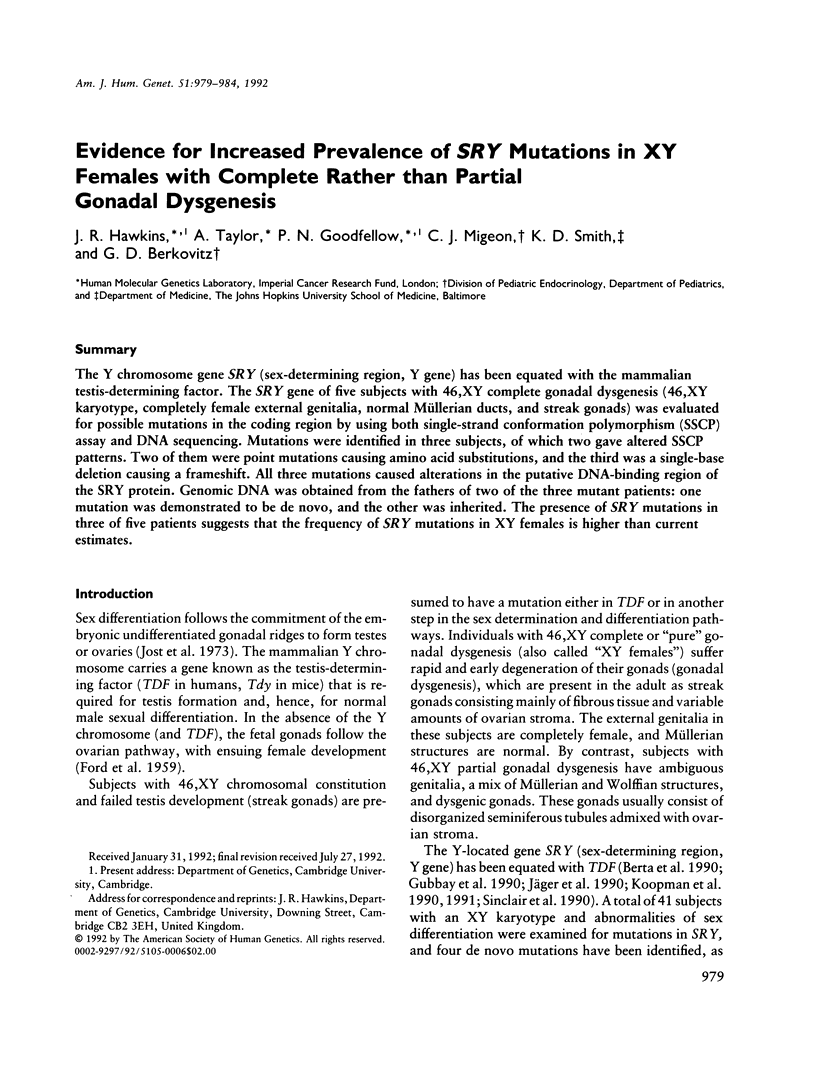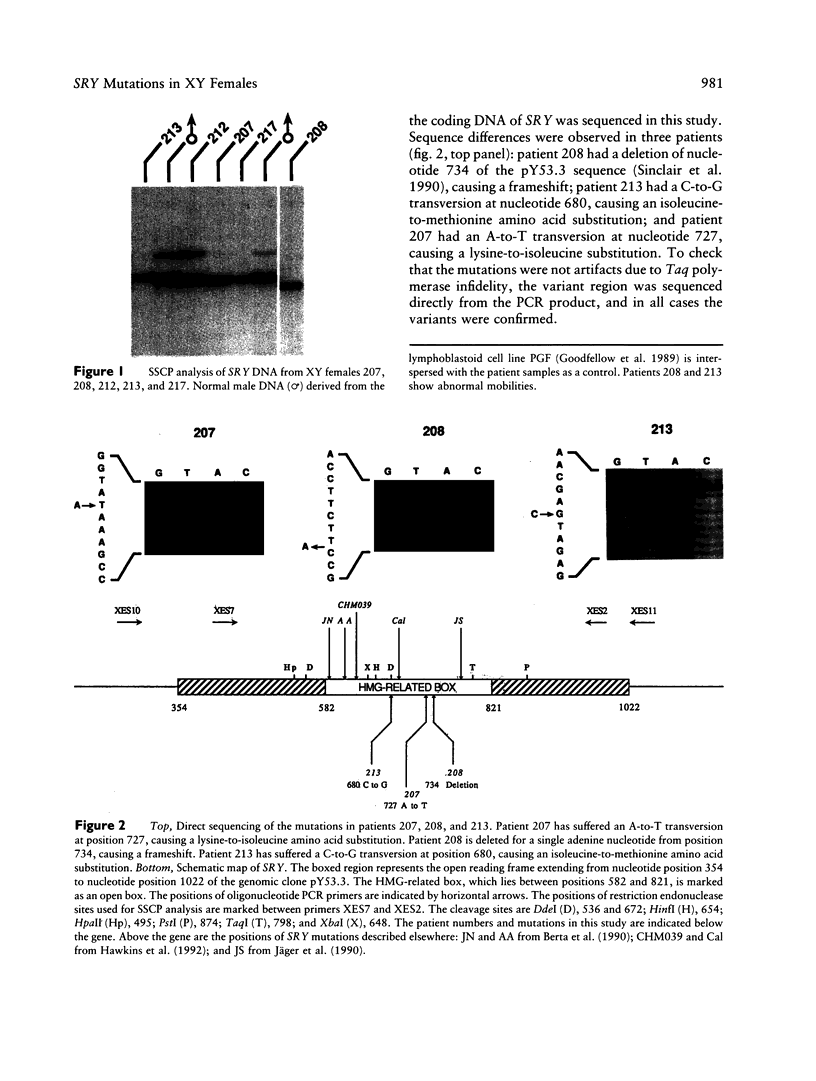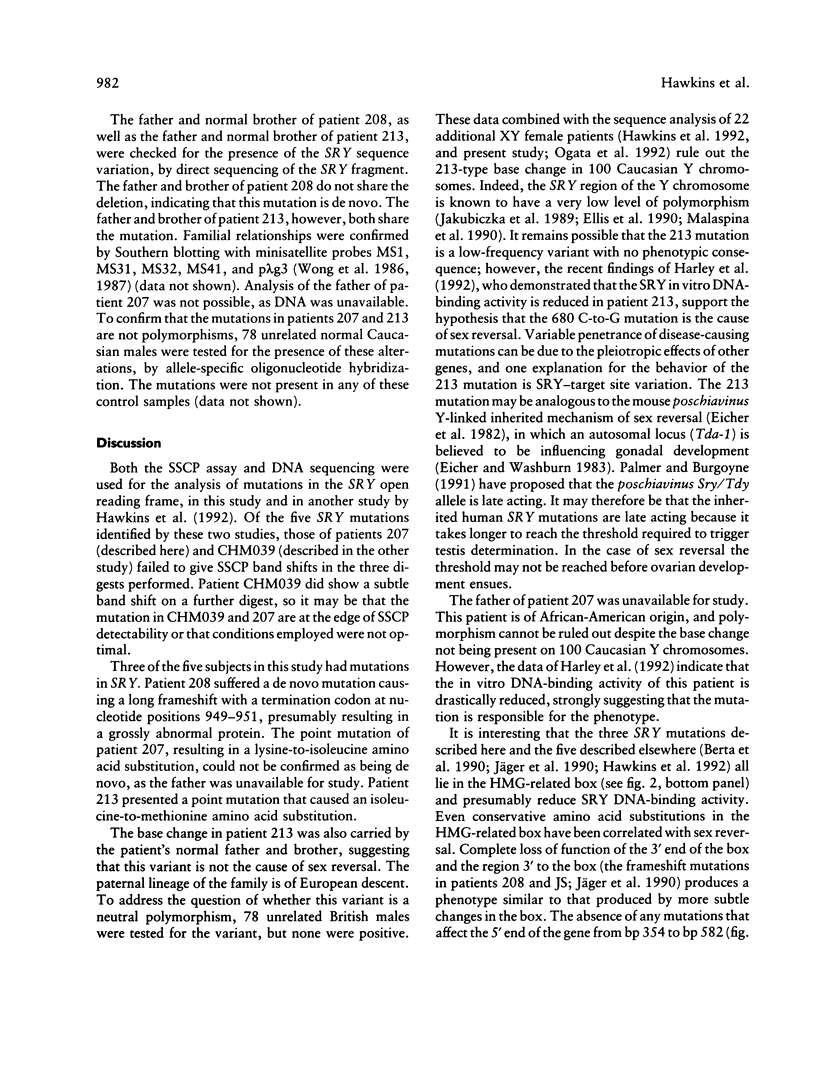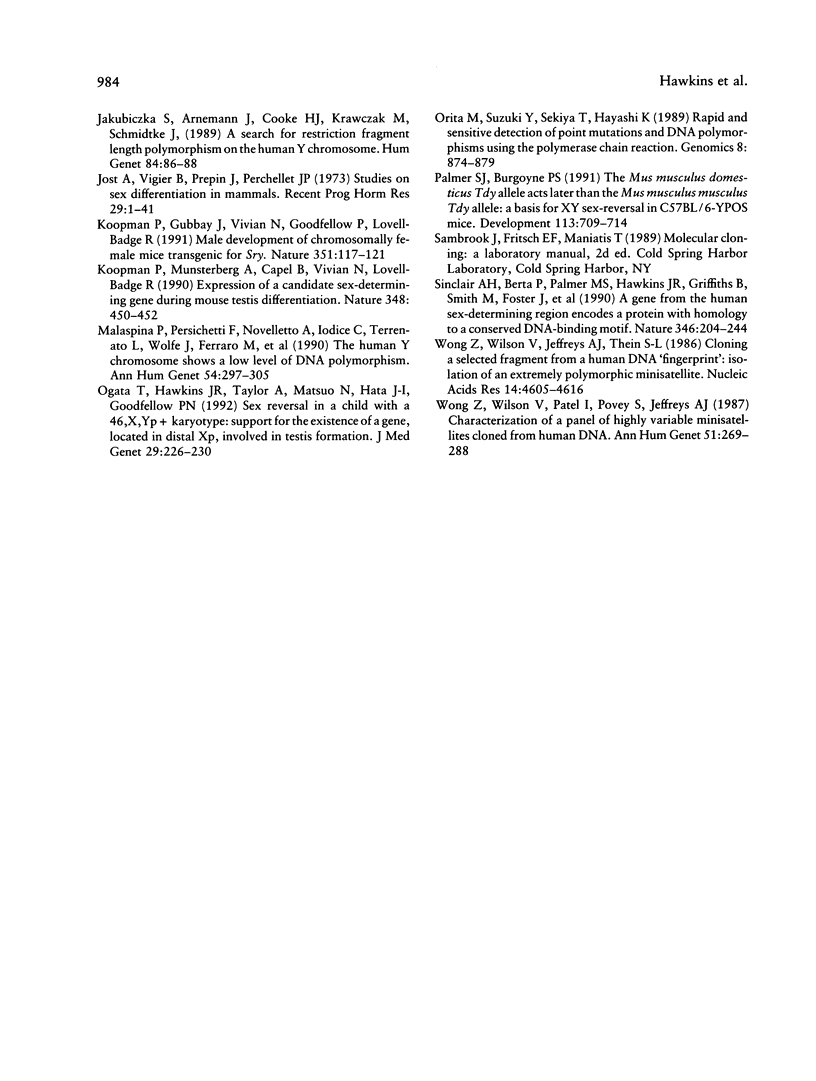Abstract
The Y chromosome gene SRY (sex-determining region, Y gene) has been equated with the mammalian testis-determining factor. The SRY gene of five subjects with 46,XY complete gonadal dysgenesis (46,XY karyotype, completely female external genitalia, normal Müllerian ducts, and streak gonads) was evaluated for possible mutations in the coding region by using both single-strand conformation polymorphism (SSCP) assay and DNA sequencing. Mutations were identified in three subjects, of which two gave altered SSCP patterns. Two of them were point mutations causing amino acid substitutions, and the third was a single-base deletion causing a frameshift. All three mutations caused alterations in the putative DNA-binding region of the SRY protein. Genomic DNA was obtained from the fathers of two of the three mutant patients: one mutation was demonstrated to be de novo, and the other was inherited. The presence of SRY mutations in three of five patients suggests that the frequency of SRY mutations in XY females is higher than current estimates.
Full text
PDF





Images in this article
Selected References
These references are in PubMed. This may not be the complete list of references from this article.
- Berkovitz G. D., Fechner P. Y., Zacur H. W., Rock J. A., Snyder H. M., 3rd, Migeon C. J., Perlman E. J. Clinical and pathologic spectrum of 46,XY gonadal dysgenesis: its relevance to the understanding of sex differentiation. Medicine (Baltimore) 1991 Nov;70(6):375–383. doi: 10.1097/00005792-199111000-00003. [DOI] [PubMed] [Google Scholar]
- Berta P., Hawkins J. R., Sinclair A. H., Taylor A., Griffiths B. L., Goodfellow P. N., Fellous M. Genetic evidence equating SRY and the testis-determining factor. Nature. 1990 Nov 29;348(6300):448–450. doi: 10.1038/348448A0. [DOI] [PubMed] [Google Scholar]
- Casanova J. L., Pannetier C., Jaulin C., Kourilsky P. Optimal conditions for directly sequencing double-stranded PCR products with sequenase. Nucleic Acids Res. 1990 Jul 11;18(13):4028–4028. doi: 10.1093/nar/18.13.4028. [DOI] [PMC free article] [PubMed] [Google Scholar]
- Church G. M., Gilbert W. Genomic sequencing. Proc Natl Acad Sci U S A. 1984 Apr;81(7):1991–1995. doi: 10.1073/pnas.81.7.1991. [DOI] [PMC free article] [PubMed] [Google Scholar]
- Eicher E. M., Washburn L. L. Inherited sex reversal in mice: identification of a new primary sex-determining gene. J Exp Zool. 1983 Nov;228(2):297–304. doi: 10.1002/jez.1402280213. [DOI] [PubMed] [Google Scholar]
- Eicher E. M., Washburn L. L., Whitney J. B., 3rd, Morrow K. E. Mus poschiavinus Y chromosome in the C57BL/6J murine genome causes sex reversal. Science. 1982 Aug 6;217(4559):535–537. doi: 10.1126/science.7089579. [DOI] [PubMed] [Google Scholar]
- Ellis N., Taylor A., Bengtsson B. O., Kidd J., Rogers J., Goodfellow P. Population structure of the human pseudoautosomal boundary. Nature. 1990 Apr 12;344(6267):663–665. doi: 10.1038/344663a0. [DOI] [PubMed] [Google Scholar]
- FORD C. E., JONES K. W., POLANI P. E., DE ALMEIDA J. C., BRIGGS J. H. A sex-chromosome anomaly in a case of gonadal dysgenesis (Turner's syndrome). Lancet. 1959 Apr 4;1(7075):711–713. doi: 10.1016/s0140-6736(59)91893-8. [DOI] [PubMed] [Google Scholar]
- Goodfellow P. J., Nevanlinna H. A., Gorman P., Sheer D., Lam G., Goodfellow P. N. Assignment of the gene encoding the beta-subunit of the human fibronectin receptor (beta-FNR) to chromosome 10p11.2. Ann Hum Genet. 1989 Jan;53(Pt 1):15–22. doi: 10.1111/j.1469-1809.1989.tb01118.x. [DOI] [PubMed] [Google Scholar]
- Gubbay J., Collignon J., Koopman P., Capel B., Economou A., Münsterberg A., Vivian N., Goodfellow P., Lovell-Badge R. A gene mapping to the sex-determining region of the mouse Y chromosome is a member of a novel family of embryonically expressed genes. Nature. 1990 Jul 19;346(6281):245–250. doi: 10.1038/346245a0. [DOI] [PubMed] [Google Scholar]
- Harley V. R., Jackson D. I., Hextall P. J., Hawkins J. R., Berkovitz G. D., Sockanathan S., Lovell-Badge R., Goodfellow P. N. DNA binding activity of recombinant SRY from normal males and XY females. Science. 1992 Jan 24;255(5043):453–456. doi: 10.1126/science.1734522. [DOI] [PubMed] [Google Scholar]
- Hawkins J. R., Taylor A., Berta P., Levilliers J., Van der Auwera B., Goodfellow P. N. Mutational analysis of SRY: nonsense and missense mutations in XY sex reversal. Hum Genet. 1992 Feb;88(4):471–474. doi: 10.1007/BF00215684. [DOI] [PubMed] [Google Scholar]
- Jakubiczka S., Arnemann J., Cooke H. J., Krawczak M., Schmidtke J. A search for restriction fragment length polymorphism on the human Y chromosome. Hum Genet. 1989 Dec;84(1):86–88. doi: 10.1007/BF00210680. [DOI] [PubMed] [Google Scholar]
- Jost A., Vigier B., Prépin J., Perchellet J. P. Studies on sex differentiation in mammals. Recent Prog Horm Res. 1973;29:1–41. doi: 10.1016/b978-0-12-571129-6.50004-x. [DOI] [PubMed] [Google Scholar]
- Jäger R. J., Anvret M., Hall K., Scherer G. A human XY female with a frame shift mutation in the candidate testis-determining gene SRY. Nature. 1990 Nov 29;348(6300):452–454. doi: 10.1038/348452a0. [DOI] [PubMed] [Google Scholar]
- Koopman P., Gubbay J., Vivian N., Goodfellow P., Lovell-Badge R. Male development of chromosomally female mice transgenic for Sry. Nature. 1991 May 9;351(6322):117–121. doi: 10.1038/351117a0. [DOI] [PubMed] [Google Scholar]
- Koopman P., Münsterberg A., Capel B., Vivian N., Lovell-Badge R. Expression of a candidate sex-determining gene during mouse testis differentiation. Nature. 1990 Nov 29;348(6300):450–452. doi: 10.1038/348450a0. [DOI] [PubMed] [Google Scholar]
- Malaspina P., Persichetti F., Novelletto A., Iodice C., Terrenato L., Wolfe J., Ferraro M., Prantera G. The human Y chromosome shows a low level of DNA polymorphism. Ann Hum Genet. 1990 Oct;54(Pt 4):297–305. doi: 10.1111/j.1469-1809.1990.tb00385.x. [DOI] [PubMed] [Google Scholar]
- Ogata T., Hawkins J. R., Taylor A., Matsuo N., Hata J., Goodfellow P. N. Sex reversal in a child with a 46,X,Yp+ karyotype: support for the existence of a gene(s), located in distal Xp, involved in testis formation. J Med Genet. 1992 Apr;29(4):226–230. doi: 10.1136/jmg.29.4.226. [DOI] [PMC free article] [PubMed] [Google Scholar]
- Orita M., Suzuki Y., Sekiya T., Hayashi K. Rapid and sensitive detection of point mutations and DNA polymorphisms using the polymerase chain reaction. Genomics. 1989 Nov;5(4):874–879. doi: 10.1016/0888-7543(89)90129-8. [DOI] [PubMed] [Google Scholar]
- Palmer S. J., Burgoyne P. S. The Mus musculus domesticus Tdy allele acts later than the Mus musculus musculus Tdy allele: a basis for XY sex-reversal in C57BL/6-YPOS mice. Development. 1991 Oct;113(2):709–714. doi: 10.1242/dev.113.2.709. [DOI] [PubMed] [Google Scholar]
- Sinclair A. H., Berta P., Palmer M. S., Hawkins J. R., Griffiths B. L., Smith M. J., Foster J. W., Frischauf A. M., Lovell-Badge R., Goodfellow P. N. A gene from the human sex-determining region encodes a protein with homology to a conserved DNA-binding motif. Nature. 1990 Jul 19;346(6281):240–244. doi: 10.1038/346240a0. [DOI] [PubMed] [Google Scholar]
- Wong Z., Wilson V., Jeffreys A. J., Thein S. L. Cloning a selected fragment from a human DNA 'fingerprint': isolation of an extremely polymorphic minisatellite. Nucleic Acids Res. 1986 Jun 11;14(11):4605–4616. doi: 10.1093/nar/14.11.4605. [DOI] [PMC free article] [PubMed] [Google Scholar]
- Wong Z., Wilson V., Patel I., Povey S., Jeffreys A. J. Characterization of a panel of highly variable minisatellites cloned from human DNA. Ann Hum Genet. 1987 Oct;51(Pt 4):269–288. doi: 10.1111/j.1469-1809.1987.tb01062.x. [DOI] [PubMed] [Google Scholar]




